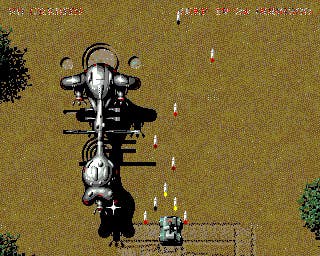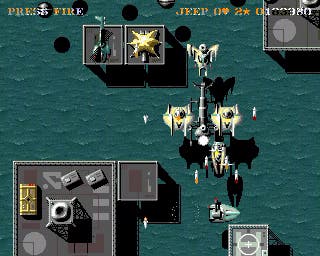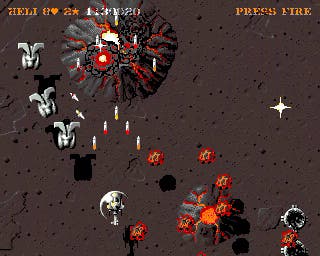SWIV retrospective
The worm that turned.
After crashing and burning in 2D shoot-em-ups for more years than I care to remember, I've often wished for lightning-fast reflexes. But there's only one shmup that ever got me thinking about the insane effort that it takes to reach the speed of light. That game was SWIV.
In the category of homegrown 16-bit shooters, it has no equal. But in truth, it did not spring, unbidden and sui generis, from the rich creative soup of 1991 games development. SWIV, as a copper might put it, had previous.
A reboot used to be something that was just between you and your personal computer. These days, it means Domestos-level slate-cleaning, sloughing off the past to re-imagine an intellectual property in a way that hopefully brings the money back in. SWIV was a reboot before that word had attained its current Hollywood-tinged usage. In the games mag language of the time, it was more of a pseudo-sequel - or, if you wanted to get fancy, 'spiritual successor' - to Tecmo's late-1980s arcade staple Silkworm, an addictive side-scrolling shoot-em-up in which a helicopter and/or jeep took on waves of militaristic enemies.

These included weird pogo-sticking helicopters, floating mines and a mid-level chopper with a goose-necked cockpit that would dish out power-ups once destroyed. Unlike most other arcade games, Silkworm's choice between heli and jeep offered up two distinct play styles. The heli could swoop and soar over the entire screen but could only shoot forward. The jeep had a wider range of firing angles but was restricted to trundling along the ground, at the mercy of road bombs and missile silos, although it could perform a teeny bunny hop on demand. At a time when 20p felt like a considerable sum to invest, no-one willingly chose the jeep.
The inevitable home computer conversions of Silkworm were handled by UK developers The Sales Curve, and for their next project, they stuck pretty rigidly with the concept of a helicopter and/or jeep against overwhelming military odds - they just ditched all the creative restrictions and hassle of the arcade licence. According to the snazzy blueprints that flash up in the pre-game introduction, SWIV is just an acronym for the Special Weapons Interdiction Vehicle you pilot into battle. But if you chose to interpret it as Silkworm 4... well, that was on you, soldier.
In SWIV, the heli could only fire forwards, while the jeep had a range of firing angles, and a teeny bunny hop. There were floating mines, goose-necked helicopters that eventually surrendered power-ups, and wave upon wave of militaristic enemies, though none of them pogo-sticked (though some skimmed amphibiously over water like lethal flying fish). Rather damningly, the concussive, phased explosions caused by the relentless carnage were very obviously lifted directly from the 16-bit Silkworm port. They still sounded amazing.
What The Sales Curve had done, in less than two years, was mature the basic concept of Silkworm into something far richer, simply by radically changing perspective. Instead of a side-scrolling shoot-em-up, this was a vertically scrolling shoot-em-up - which sounds like a simple thing on paper, but in reality, changed the game fundamentally. That shift of perspective from side-on to top-down created scope for graphical improvements and a frightening escalation of mayhem. It looked amazing, and played brilliantly.
No wonder Tecmo didn't pursue any legal sanction against SWIV: this was their bare-bones blueprint elevated to a frankly dazzling level. The Sales Curve's innovation and creativity wasn't restricted to its interpretation of intellectual property law.

SWIV was also an unprecedented feat of focused technical skill. Instead of breaking up the action into discrete levels like shmups immemorial, the game created the illusion of a single, unbroken 40-minute attack run: the equivalent of 236 screens rolling out like a bomb-cratered carpet, with no data-accessing pauses or juddering (on the 16-bit versions, at least). This was thanks to the ahead-of-its-time Dynamic Loading System, created by programmer Ron Pieket Weeserik, that rare technical bullet-point that earned a place on the front of the box.
The SWIV mission began in a ghost town and crawled through an military airport, a petrified forest, various bodies of water, a desert, an aeronautical graveyard and a volcanic mountain range, becoming more organic and alien-like as it rolled implacably toward an ending that remained, for the most part, tantalisingly out of reach. The colour palette shifted as you progressed - the sea bits required more blues, obviously - a programming sleight-of-hand that might have been more perceptible if not for the non-stop pandemonium.
On the first few plays, whether as a one-player heli or two-player air-and-ground team, the SWIV scrolling speed felt leisurely, almost too slow: more adagio than allegretto. That impression lasted roughly 17 seconds, as waves of super-incentivised enemies swarmed your vehicle. Stocking up on multiple spread-firing power-ups, released by those gooseneck choppers, was the only way to proceed. (The liberal detonation of bubble-like smart-bombs was another useful way to grab precious seconds of me-time before the next attack wing.)
Pause mode was only a keyboard press away, but the implied relentlessness functioned as a psychological mindgame. The inexorable scrolling only paused for SWIV's equivalent of end-of-level bosses, military installations bristling with missiles and mega-lasers that were about as friendly and relaxing as your average motorway service station.
War is hell, but SWIV looked beautiful. A self-confessed Thunderbirds nut, artist Ned Langman created a fleet of choppers, planes and tanks that managed to combine distinct personalities with an unifying utilitarian military design aesthetic. These craft looked almost realistic, until you factored in their suicidal attack patterns. There were also occasional hat-tips to shooters past, from lethal spinning hubcaps to rotating slabs of obdurate metal that could have floated in from Namco's classic Xevious.

While the graphics looked exciting enough to have come from a mysterious Japanese import on the PC Engine or NeoGeo, the humour underneath the frantic surface of SWIV felt more like a callback to the UK's 8-bit bedroom coding boom. Hidden missile emplacements popped out of the ground like a game of Whac-A-Mole. A mysterious alien ship lifted off to reveal a pristine crop circle. The sight of a dramatically dried-up riverbed was undercut by a tiny shopping trolley. The high-score tables for heli and jeep reset each time you booted up, sometimes packed with classic Doctor Who actors, sometimes with gameshow hosts. SWIV was probably the only shoot-em-up to feature Gloria Hunniford's name in its attract mode.
Over two decades later, SWIV still feels like the apex of a certain game archetype, partly because of the technical and graphical skill on display, and partly because it was released just before the industry bet the farm on 3D. At the time, no-one seemed to evaluate and then build on its achievements (although The Sales Curve did go on to produce a semi-sequel - a "spiritual successor", if you like - for the Super Nintendo). SWIV was a Goldilocks moment in gaming's evolution, but also turned out to be a bit of a dead end.
What it still has is that hook - by pressing the fire button, you're tacitly agreeing to spend the next 40 minutes grappling with the game. No checkpoints. No insta-saves. And no chance of completing it if you're playing as the jeep. When you had exhausted all your credits, SWIV would tell you how may missiles you fired (usually tens of thousands), plus how many enemies you destroyed and how many 'escaped', as if you weren't trying to vapourise every last one of them.
Then it told you far you'd made it through the game, and it was nudging that percentage up toward 100% - hell, up to 70% would be good - that made me sympathise with scientists trying to push anything toward the speed of light, where literally redoubled efforts will only nudge you a fraction further along.
Completing SWIV - for most mortals, an impossibility without the cheats available in a gelded, questionably legal version of the game - was bittersweet. After an animated explosion, you were congratulated on eliminating the forces of evil. "Humanity can live forever in peace and harmony," read the valedictory screen. "So they won't need an army anymore. Your SWIV unit is being disbanded and you are now unemployed. Your P45 and severance pay are in the post." It was more ahead of its time than it realised.

